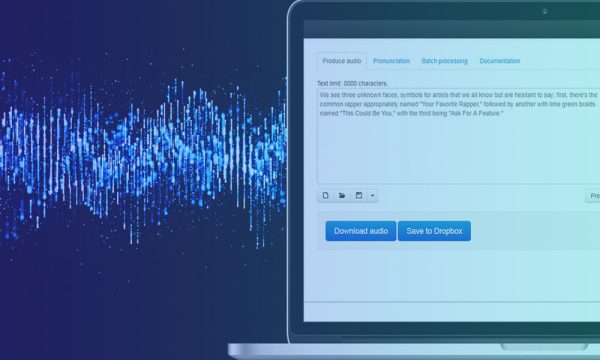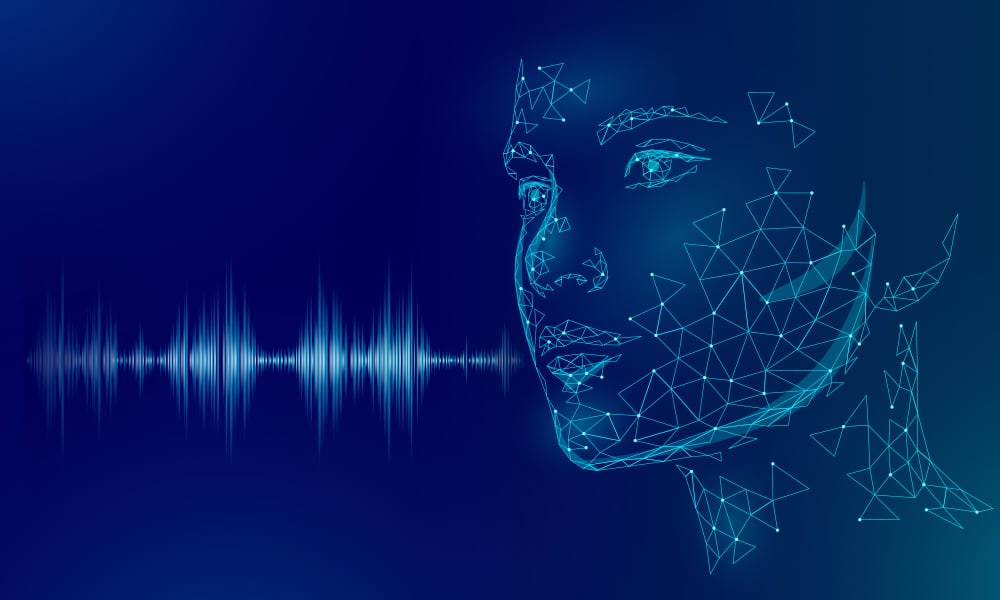Automatic speech recognition (ASR) has come a long way. Though it was invented long ago, it was hardly ever used by anyone. However, time and technology have now changed significantly. Audio transcription has substantially evolved.
Technologies such as AI (Artificial Intelligence) have powered the process of audio-to-text translation for quick and accurate results. As a result, its applications in the real world have also increased, with some popular apps like Tik Tok, Spotify, and Zoom embedding the process into their mobile apps.
So let us explore ASR and discover why it is one of the most popular technologies in 2022.
What is speech to text?
Speech-to-text (STT), also called automatic speech recognition (ASR), converts spoken audio into written text. Modern systems are software services that analyze audio signals and output words with timestamps and confidence scores.
For teams building contact-center, healthcare, and voice UX, STT is the gateway to searchable, analyzable conversations, assistive captions, and downstream AI like summarization or QA.
Common Names of Speech to Text
This advanced speech recognition technology is also popular and referred to by the names:
- Automatic speech recognition (ASR)
- Speech recognition
- Computer speech recognition
- Audio transcription
- Screen Reading
Applications of speech-to-text technology
Contact centers
Real-time transcripts power live agent assist; batch transcripts drive QA, compliance audits, and searchable call archives.
Example: Use streaming ASR to surface real-time prompts during a billing dispute, then run batch transcription after the call to score QA and auto-generate the summary.
Healthcare
Clinicians dictate notes and get visit summaries; transcripts support coding (CPT/ICD) and clinical documentation—always with PHI safeguards.
Example: A provider records a consultation, runs ASR to draft the SOAP note, and auto-highlights drug names and vitals for coder review with PHI redaction applied.
Media & education
Generate captions/subtitles for lectures, webinars, and broadcasts; add light human editing when you need near-perfect accuracy.
Example: A university transcribes lecture videos in batch, then a reviewer fixes names and jargon before publishing accessible subtitles.
Voice products & IVR
Wake-word and command recognition enable hands-free UX in apps, kiosks, vehicles, and smart devices; IVR uses transcripts to route and resolve.
Example: A banking IVR recognizes “freeze my card,” confirms details, and triggers the workflow—no keypad navigation required.
Operations & knowledge
Meetings and field calls become searchable text with timestamps, speakers, and action items for coaching and analytics.
Example: Sales calls are transcribed, tagged by topic (pricing, objections), and summarized; managers filter by “renewal risk” to plan follow-ups.
Why should you use speech to text?
- Make conversations discoverable. Turn hours of audio into searchable text for audits, training, and customer insights.
- Automate manual transcription. Reduce turnaround time and cost versus human-only workflows, while keeping a human pass where quality must be perfect.
- Power downstream AI. Transcripts feed summarization, intent/topic extraction, compliance flags, and coaching.
- Improve accessibility. Captions and transcripts help users with hearing loss and improve UX in noisy environments.
- Support real-time decisions. Streaming ASR enables on-call guidance, real-time forms, and live monitoring.
Benefits of speech-to-text technology
Speed & mode flexibility
Streaming gives sub-second partials for live use; batch chews through backlogs with richer post-processing.
Example: Stream transcripts for agent assist; batch re-transcribe later for QA-quality archives.
Quality features built in
Get diarization, punctuation/casing, timestamps, and phrase hints/custom vocabulary to handle jargon.
Example: Label Doctor/Patient turns and boost medication names so they transcribe correctly.
Deployment choice
Use cloud APIs for scale/updates or on-prem/edge containers for data residency and low latency.
Example: A hospital runs ASR in its data center to keep PHI on-prem.
Customization & multilingual
Close accuracy gaps with phrase lists and domain adaptation; support multiple languages and code-switching.
Example: A fintech app boosts brand names and tickers in English/Hinglish, then fine-tunes for niche terms.
Comprehending the Working of Automatic Speech Recognition

The working of audio-to-text translation software is complex and involves the implementation of multiple steps. As we know, speech-to-text is an exclusive software designed to convert audio files into an editable text format; it does it by leveraging voice recognition.
Process
- Initially, using an analog-to-digital converter, a computer program applies linguistic algorithms to the provided data to distinguish vibrations from auditory signals.
- Next, the relevant sounds are filtered by measuring the sound waves.
- Further, the sounds are distributed/segmented into hundredths or thousandths of seconds and matched against phonemes (A measurable unit of sound to differentiate one word from another).
- The phonemes are further run through a mathematical model to compare the existing data with well-known words, sentences, and phrases.
- The output is in a text or computer-based audio file.
[Also Read: A Comprehensive Overview of Automatic Speech Recognition]
What are the Uses of Speech to Text?
There are multiple automatic speech recognition software uses, such as
- Content Search: Most of us have shifted from typing letters on our phones to pressing a button for the software to recognize our voice and provide the desired results.
- Customer Service: Chatbots and AI assistants that can guide the customers through the few initial steps of the process have become common.
- Real-Time Closed Captioning: With increased global access to content, closed captioning in real-time has become a prominent and significant market, pushing ASR forward for its use.
- Electronic Documentation: Several administration departments have started using ASR to fulfill documentation purposes, catering to better speed and efficiency.
What are the Key Challenges to Speech Recognition?
Accents and dialects. The same word can sound very different across regions, which confuses models trained on “standard” speech. The fix is simple: collect and test with accent-rich audio, and add phrase/pronunciation hints for brand, place, and person names.
Context and homophones. Picking the right word (“to/too/two”) needs surrounding context and domain knowledge. Use stronger language models, adapt them with your own domain text, and validate critical entities like drug names or SKUs.
Noise and poor audio channels. Traffic, crosstalk, call codecs, and far-field mics bury important sounds. Denoise and normalize audio, use voice-activity detection, simulate real noise/codecs in training, and prefer better microphones where you can.
Code-switching and multilingual speech. People often mix languages or switch mid-sentence, which breaks single-language models. Choose multilingual or code-switch-aware models, evaluate on mixed-language audio, and maintain locale-specific phrase lists.
Multiple speakers and overlap. When voices overlap, transcripts blur “who said what.” Enable speaker diarization to label turns, and use separation/beamforming if multi-mic audio is available.
Video cues in recordings. In video, lip movements and on-screen text add meaning that audio alone can miss. Where quality matters, use audio-visual models and pair ASR with OCR to capture slide titles, names, and terms.
Annotation and labeling quality. Inconsistent transcripts, wrong speaker tags, or sloppy punctuation undermine both training and evaluation. Set a clear style guide, audit samples regularly, and keep a small gold set to measure annotator consistency.
Privacy and compliance. Calls and clinical recordings can contain PII/PHI, so storage and access must be tightly controlled. Redact or de-identify outputs, restrict access, and choose cloud vs on-prem/edge deployments to meet your policy.
How to choose the best speech-to-text vendor
Pick a vendor by testing on your audio (accents, devices, noise) and weighing accuracy against privacy, latency, and cost. Start small, measure, then scale.
Define needs first
- Use cases: streaming, batch, or both
- Languages/accents (incl. code-switching)
- Audio channels: phone (8 kHz), app/desktop, far-field
- Privacy/residency: PII/PHI, region, retention, audit
- Constraints: latency target, SLA, budget, cloud vs on-prem/edge
Evaluate on your audio
- Accuracy: WER + entity accuracy (jargon, names, codes)
- Multi-speaker: diarization quality (who spoke when)
- Formatting: punctuation, casing, numbers/dates
- Streaming: TTFT/TTF latency + stability
- Features: phrase lists, custom models, redaction, timestamps
Ask in the RFP
- Show raw results on our test set (by accent/noise)
- Provide p50/p95 streaming latency on our clips
- Diarization accuracy for 2–3 speakers with overlap
- Data handling: in-region processing, retention, access logs
- Path from phrase lists → custom model (data, time, cost)
Watch for red flags
- Great demo, weak results on your audio
- “We’ll fix with fine-tuning” but no plan/data
- Hidden fees for diarization/redaction/storage
[Also Read: Understanding the Collection Process of Audio Data for Automatic Speech Recognition]
The future of speech-to-text technology
Bigger multilingual “foundation” models. Expect single models that cover 100+ languages with better low-resource accuracy, thanks to massive pre-training and light fine-tuning.
Speech + translation in one stack. Unified models will handle ASR, speech-to-text translation, and even speech-to-speech—reducing latency and glue code.
Smarter formatting and diarization by default. Auto punctuation, casing, numbers, and reliable “who-spoke-when” labeling will increasingly be built-in for both batch and streaming.
Audio-visual recognition for tough environments. Lip cues and on-screen text (OCR) will boost transcripts when audio is noisy—already a fast-moving research area and early product prototypes.
Privacy-first training and on-device/edge. Federated learning and containerized deployments will keep data local while still improving models—important for regulated sectors.
Regulation-aware AI. EU AI Act timelines mean more transparency, risk controls, and documentation baked into STT products and procurement.
Richer evaluation beyond WER. Teams will standardize on entity accuracy, diarization quality, latency (TTFT/TTF), and fairness across accents/devices, not just headline WER.
How Shaip helps you get there
As these trends land, success still hinges on your data. Shaip supplies accent-rich multilingual datasets, PHI-safe de-identification, and gold test sets (WER, entity, diarization, latency) to fairly compare vendors and tune models—so you can adopt the future of STT with confidence. Talk to Shaip’s ASR data experts to plan a quick pilot.










